This is the 6th article (S No: VI-360.06) of the series “Visit India 360”. It’s an endeavor initiated by N4M, through a series of articles highlighting the various facets of ‘Indian Tourism’, and in the process synch with the ongoing efforts to make India the preferred destination of World Tourism.
The seven states located in North East India, the country’s easternmost region, are called the Seven Sisters of the North East. These seven states are Arunachal Pradesh, Assam, Manipur, Meghalaya, Mizoram, Nagaland and Tripura, which comprise a distinct geographic, administrative and political region. This region is a picturesque kaleidoscope of undulating green hills, rolling valleys and peaceful and tranquil towns and hamlets.The dazzling and invigorating rays of the sun visit this part of the country the earliest.
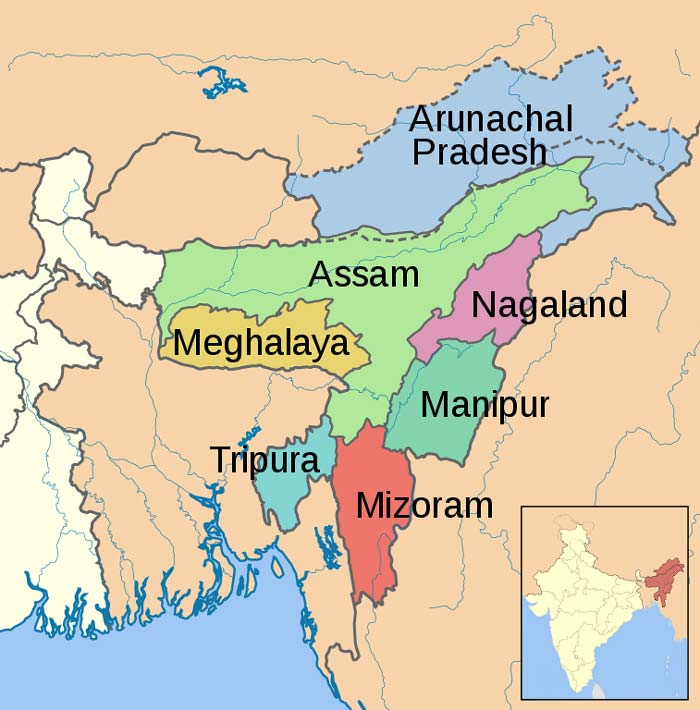
The area of North East India is approximately 2.6 lakh square km that is nearly 8% of India’s land area. Its international borders are shared by 7 countries.One of the world’s biodiversity hotspots, the region is home to diverse cultures, happy and welcoming people, a bountiful flora and fauna and panoramic terrain and landscapes.
The north eastern states make up the North Eastern Council (NEC), an acting agency formed in 1971 for the development of the region. Another north eastern state, Sikkim, was inducted as the 8th state of the region in 2002 and was proclaimed as a “brother” to the “seven sisters”. It is separated from these states by Chicken’s Neck or the Siliguri Corridor, a 20 km long stretch, flanked on either side by Bangladesh and Bhutan that connects them to West Bengal. Guwahati, the largest metro in Assam and the north east is the gateway to the region.
These states comprise a natural paradise with an enormously diverse flora and fauna besides a rich history and variety of deep-rooted cultures and traditions. To attract tourists, these states possess everything such as colourful festivals and fairs, scenic village tours, verdant greenery, brilliant landscapes which are not witnessed elsewhere, serene and relaxing hill stations and quaint towns, exciting adventure spots besides a welcoming and warm local population.
Arunachal Pradesh
Located in the extreme northeast of India, Arunachal Pradesh or “The Land of the Rising Sun” is the largest state in the northeast. With Assam and Nagaland by its side, the state shares its international borders with Bhutan, China and Myanmar. The pristine and serene environs of this least unexplored state provides a beautiful bouquet of lush green forests, snow-capped mountain peaks and gurgling streams to the discerning tourists. 26 indigenous tribes call the state their home and their different traditions have given rise to its unique culture. The mighty Brahmaputra enters India at Pasighat, the oldest town in the state. The world’s second largest Buddhist monastery is located at Tawang.
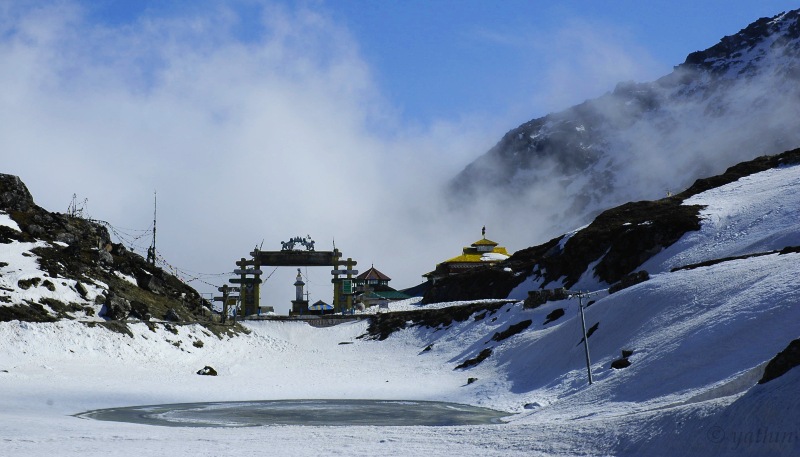
Arunachal Pradesh has a rich biodiversity which comprises of a rich and strikingly colourful flora and fauna. The state is rich in its biodiversity. Around 500 species of spectacular orchids grow in the state, some of them with exotic names like Draupadi Pushp and Sita Pushp, named so as they were believed to have been worn by Draupadi and Sita. Animals like leopard, elephant, white browed gibbon, jungle cat, red panda, musk deer, wild buffalo, snow leopard, goral goat and the great Indian hornbill. A completely different and mind-blowing experience is to be had by visiting tourist spots like Bhalukpong, Dirang, Parshuram Kund, Sela Pass, Sessa Orchid Sanctuary, Mouling National Park, Namdapha National Park, Mehao Wildlife Sanctuary and Pakhui Wildlife Sanctuary. The Talle Valley Wildlife Sanctuary is located in Ziro Valley which is also known its annual music festival, held in the month of September.
Assam
Assam, the second largest state of northeastern India, is rightly called “the tea state” as it provides around 60% of the total tea to the Indian market. The lush tea estates, green grasslands, wetlands and rainforests bestow a verdant setting to the state which lies between Bhutan, Arunachal Pradesh, Meghalaya, Mizoram, Manipur, Nagaland and Tripura. The gigantic Brahmaputra passes through this beautiful piece of land and provides water to 20 wildlife sanctuaries and 5 national parks that sustain a variety of flora and fauna.The varied wildlife thriving here comprises of one-horned Indian rhinoceros, tiger, water buffalo, pygmy hog, and different types of exotic birds.The unparalleled beauty of the place satiates the wanderlust of tourists.
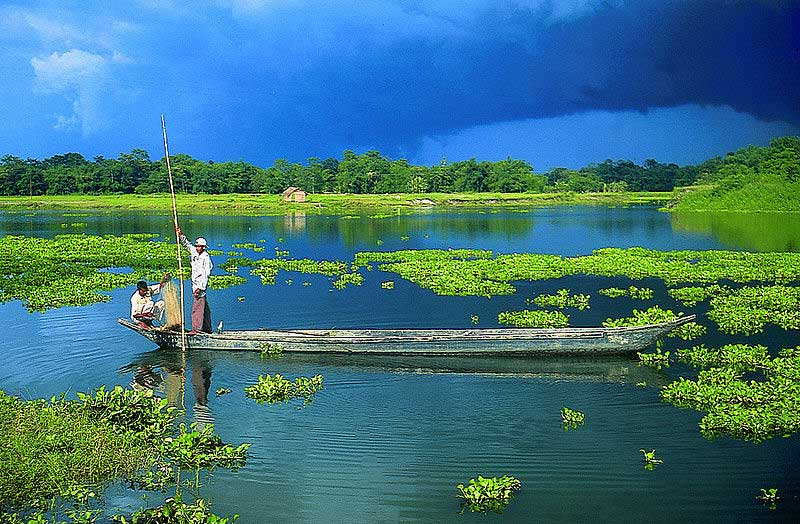
Assam is also home to 2World Heritage Sites of Manas and Kaziranga National Parks. The largest riverine island in the world, the majestic Majuli, is also here, bang in the middle of Brahmaputra. The world’s oldest operating oil refinery is located at Digboi. Besides the tea and oil refinery, Assam is also renowned for its three types of unique silk. The quaint town of Sualkuchi, known for its silk, is called the “Manchester of Assam”. Haflong or “White Ant Hillock” is the only hill station of the state. Known for its beautiful landscape, valleys and hills, it is also called the “Switzerland of the East”.
The Kamakhya Temple, located in Guwahati, is one of the oldest pilgrimage sites in the country which is thronged by thousands of devotees from all over India every year.The Bihu festival, celebrated thrice a year in December, January and April, besides the Bihu dance, is well renowned.
Meghalaya
Meghalaya or “The Abode of Clouds” as the name means in Sanskrit, is the wettest place on the earth and is an important one in the seven sister states of india. This mountainous state shares its borders with Bangladesh and Assam and has highland plateaus and stretches of valleys. It is also known as “Scotland of the East” because of its lush landscape, waterfalls and gurgling streams. Meghalaya has a number of rain-fed and seasonal rivers which have given rise to waterfalls and created deep gorges at places. Mawsynram village receives the most rain in a year in the world whereas Cherrapunji in Khasi Hills holds the record for receiving the most rain in a month. Situated 90 km away from the capital Shillong is Mawlynnong, the cleanest village in Asia.
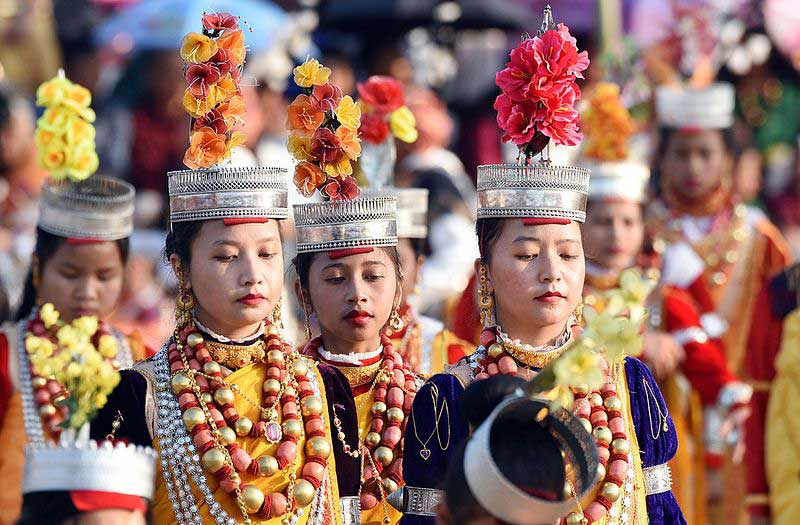
The perpetually drenched forests of the state are arguably the richest botanical habitats in the Asian continent. A veritable treasure trove of flora and fauna is to be found in these forests. Some of these animals are bear, small Indian civet, red panda, elephant, gaur, deer, wild buffalo, wild boar and monkeys. The hoolock gibbon is also found all over the state. Dangerous reptiles such as king cobra, Indian cobra, viper, green tree racer, python etc. are also found here. Birds found here are green pigeon, grey peacock pheasant, great Indian hornbill and the large Indian parakeet. Around 250 species of butterflies also are found here.
A sacred grove is a special feature of Meghalaya where a small portion of an ancient forest is preserved by local communities in the belief that the village deity lives there. No one is allowed to exploit the place as it is reserved for religious rituals. As a result, many rare plant and animal species are found here. The Siju Sanctuary, Nongkhyllem Wildlife Sanctuary and Baghmara Sanctuary where one can witness the insect eating pitcher plant in action. The Balphakram National Park and the Nokrek Biosphere Reserve also possess a diverse biodiversity. Other main attraction of the state are the living root bridges, made on Indian rubber trees, which are used to cross rivers and streams.The 3-km long UmshiangDouble Decker Living Root Bridge at Cherrapunji is to be seen to be believed as this man-made creation has a descent of 2400 feet. Another place worth visiting is the Nohkalikai Waterfall in Khasi hills which is the fourth highest waterfall in the world.
Another unique feature of Meghalaya is that, unlike most Indian states, the state has a matrilineal society where the lineage is traced through women.
Manipur
Manipur or the “Jeweled Land” is bound by Assam, Mizoram and Nagaland and also shares international border with Myanmar.Mother Nature has showered its bounty on the state and has bestowed it with beautiful landscape, lush green rolling hills, dense dark forests and tranquil and serene lakes besides the temples and ancient monuments.
This small and picturesque state is watered by four major rivers like the Yu, Lanye, Barak and Manipur whose originate from the local surrounding hills which, by preventing the northern cold winds from entering the valley, have provided it with a pleasingly moderate climate. The dense forests of pine, oak, teak, bamboo, cane and uningthou trees besides the charming waterfalls and the water bodies provide freshness to the already lovely environment. The hilly areas have tea, coffee, cardamom and orange plantations.
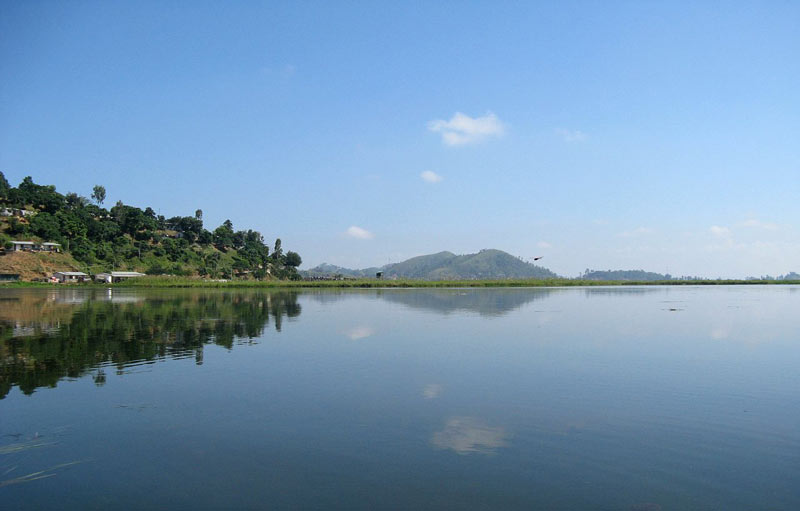
The Loktak Lake which is located around 53 km from Imphal wears two hats at the same time. It is the largest freshwater lake in India besides being the only floating lake in the world. It is famous for its phumdis (mass of soil, vegetation and organic matter) floating in it. The Keibul Lamjao National Park, the only floating national park in the world, is located on one such 40 sq. km phumdi. The animals that can be seen here are sambar, hog deer, wild boar and the sangai, the brow-antlered deer.The Khonghampat Orchidarium, located 7 km from Imphal, is considered a paradise of orchids where one can admire more than 110 different species of orchids, some of which resemble bees, lizards and moths and can drive the visitors dizzy with their heavenly fragrances.
Manipur is a land of eternal celebrations as festivals such as Yaosang,Cheiroba, Kut and NingolChakaoba hold a special significance of its polite, warm and hospitable people. These festivals are marked by traditional music and dance, merry-making traditional drinks and local delicacies.
Places worth visiting are Shri Govindji Temple which is dedicated to Lord Krishna and his consort Radha,Manipur Zoo, Khwairamband Bazar or IMA Market which is a unique market as it run solely by ladies, Kaina , Sendra Island, Phubala, Moirang and Khonghampat. People also visit the highest mud dam in the world, the Singda Dam, for hiking, trekking or to just relax.
Mizoram
The landlocked Mizoram or the “Land of the Mizos “is surrounded by Assam, Tripura and Manipur and shares international borders with Myanmar and Bangladesh.Filled to the brim with rolling hills, beautiful valleys, verdant forests, rivers, lakes and teeming wildlife, the state is a kaleidoscope of natural beauty.21 major hill ranges with different heights crisscross the state, with plains scattered in between. At 2,210 metres, the Phawngpui Tlang or the Blue Mountain, is its highest peak. The Kaladan River, originating in Myanmar, is the biggest river of the state where it is known as Chhimtuipui. Other major rivers which flow here are Tut, Tuivawl, Tlawang and Tuirial. The Tam Dil Lake and the Palak Lake also add to the already overflowing surrounding beauty.

The mild climate of Mizoram, aided by heavy monsoon rains has given rise to a huge biodiversity which can be witnessed in its flora and fauna. This heavily forested state has a variety of trees with bamboo being the most common types. Some animals found here are tiger, goral, leopard, clouded leopard, red serow, slow loris, Bengal fox, leopard cat, Asiatic black bear, capped langur, stump-tailed macaque etc. Besides, a large number of fish and reptiles abound here. This wildlife can be seen in all its majesty in the two national parks and six wildlife sanctuaries located in the state.
The peaceful land of Mizoram is inhabited by an inviting people whose traditional food provides a veritable feast for the senses. The places which one must visit are the Dampa Tiger Reserve, Vantawng Falls, Phawngpui or Blue Mountain National Park,Palak Lake, Murlen National Park, Luangmual Handicrafts Center and the quaint and peaceful town of Thenzawl.Some colourful and energetic festival celebrated in the state are the spring festival of Chapchar Kut, Pawl Kut and Mim Kut.
One of the least discovered states of the country, Mizoram has an idyllic setting that fills its visitors with a feeling of surreal grandeur.
Nagaland
The exquisite northeastern state of Nagaland has Assam, Arunachal Pradesh and Manipur on its borders. Home to 16 indigenous tribes and a large number of sub-tribes, the state has a unique culture of its own. A large part of the state lies under a lush green carpet of evergreen rainforests which bestow on it a pleasant and healthy climate. The forests have trees like bamboo, rattan, palm and mahogany besidesscrub, reeds and high grass. Some animals found in these forests are the leopard,sambar deer, tiger, elephant, fox, wild buffalo, pig-tailed macaque, hoolock gibbon, slow loris, marbled cat, porcupine dhole, Himalayan black bear etc.
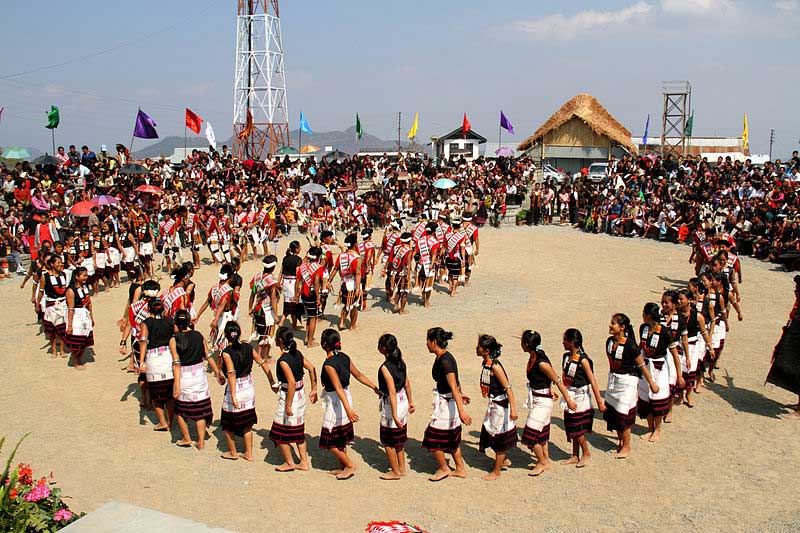
Nagaland, also known as the “Falcon Capital of the World”, has around 490 species of birds, with the great Indian hornbill having the place of pride. Around 400 species of orchids are found here which provide a colourful and fragrant setting to the state.
As all the local tribes have their own festivals and agriculture being the main profession of the state, the celebration take on the form of lively and enthusiastic expression of gratitude to the local deities for a bountiful harvest. Thus the state is also called the Land of Festivals.The state government launched the Hornbill Festival in 2000 which became an instant success with both domestic and international tourists.
The wooden houses in quiet and quaint villages of tribals besides the mysterious forests provide infuse the air with a lazy and languid feeling which has a different charm of its own. Places worth a dekko are Kohima War Cemetery in the capital, Triple Falls, Dzukou Valley, Veda Peak,Japfu Peak, Tuphema village, the Fortress Kachari ruins of old monoliths, reservoirs, temples and various tanks. The Shiva Temple in Dimapur which was built in 1961, attracts a large number of devotees on the occasion of Maha Shivratri. A visit to Wokha, with its pesticide and fertilizers free pineapples and oranges, is a must for health enthusiastic tourists.
Tripura
The third smallest state of India, Tripura has a hilly terrain and has a unique mix of Bengali and tribal culture which provides its idyllic setting of peace and harmony. On its borders lie Assam and Mizoram while its international border is shared by Bangladesh. The five mountain ranges of Boromura, Shakhan, Jampui, Atharamura and Longtharai are its sentinels. Around half of the state is covered in forests where bamboo, long grass and canes grow in plenty. The slopes of the hills are covered with evergreen forests.

The animals found in the state are leopard, porcupine, wild dog, elephant, wild boar, sambar deer, clouded leopard, gaur and barking deer. This beautiful wildlife can be seen at Clouded Leopard National Park and Rajbari National Park besides the wildlife sanctuaries located at Rowa, Gumti, Trishna and Sipahijola. It is also home to around 300 bird species, many of which throng the Rudrasagar and Gumti lakes.
The uniquely exquisite culture of the state can be experienced during the festivals of Kali Puja, Durga Puja, Dolyatra and Ashokashtami when it feels as if the state is celebrating together in a unique rhythm of colours and sounds. Besides, the state is also to be visited for its sumptuous local delicacies and trekking in the hills. Some other attractions of the state are Neermahal, the Ujjayanta Palace museum, Tripura Sundari Temple, Unakoti rock cut sculptures and Chittagong Hills.
Sikkim
The second smallest state of India, Sikkim was a late entrant to the North East Council in 2002 and was christened as the “Brother” to the seven sister states of the north east. It shares its borders with China, Nepal and Bhutan while West Bengal lies to its south. The state, lying in the eastern Himalayas, is renowned for its mountainous terrain and biodiversity. The hilly state is also home to Kanchenjunga, the third highest mountain in the world with a height of 8,586 metres and the Khangchendzonga National Park or the Kanchenjunga Biosphere Reserve, named so after the mountain, covers nearly 35% of the state and is a UNESCO World Heritage Site.
A large number of snow fed rivulets and streams flow through valleys and come together to form Teesta and Rangeet rivers. With a bevy of 28 snow covered peaks, around 200 lakes such as Gurudongmar, Tsongmo and Khecheopalri and 80 glaciers, it is also dotted with hot springs like Ralang, Yumey, Phurchachu, Borang, Yumtang and Taram Chuwhose high sulphur content waters which are therapeutic and medicinal in nature. Most places in the state enjoy a temperate climate and snowfall in the winter. This turns the place foggy, giving it a mysterious feel.
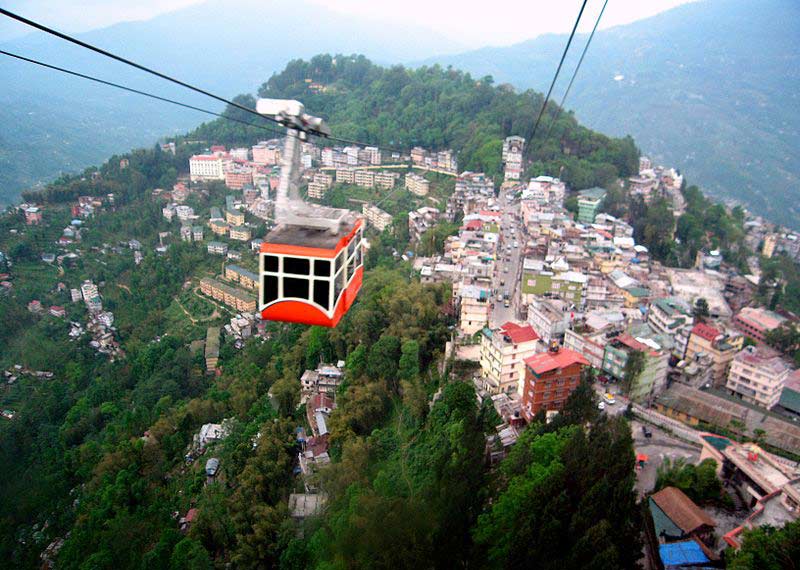
Sikkim’s forestsare teeming with a bountiful flora and fauna. Nearly 5,000 varieties of flowering plants turn the pace into a veritable lush garden. Some trees found here are bamboo, sal, fig, chestnut, oak, birch, maple besides Alpine shrub, magnolias and rhododendrons. The animals found here are red panda, snow leopard, Himalayan goral, Himalayan tahr, langur, black bear, Tibetan wolf, majestic yak etc. while birds such as snow partridge, pheasant, golden eagle, robin, woodcock and sandpiper fill the air with their wondrous cacophony.
Sikkim, though one of the smallest state in the country, is among the fast-growing ones. Its ecologically conscious government vowed to change its agriculture to fully organic and did so in a short period of 13 years. It has also successfully banned the use of plastic bottles and polystyrene products. After Guatemala, it is the largest producer of cardamom in the whole wide world.
While the whole state is a tourist paradise, Rumtek Monastery, Nathu La Pass and Namgyal Institute of Tibetology that houses rare Tibetan works, religious art and iconography deserve a special mention.
To Conclude
The North-East region is not only one of the most beautiful regions of India but also the most neglected, and understood, hence the least explored. This beautiful land inhabited by peace loving, warm, hospitable and welcoming beautiful people remain hidden from the rest of the mainland. This sad reality came about due to the apathy and sad neglect by the successive Indian governments of the past seven decades. The region is one of the most diverse in terms of cultures, traditions, languages and ethnicities yet most Indians have no idea about this fact.
The official apathy and isolation of the region gave rise to underdevelopment and poor governance which led to large scale unemployment, tribal unrest and insurgency. In the process, the connectivity with the country, both transport and communication wise, did not take off. All this hampered the vast tourism potential of the region, armed as it is with picturesque Himalayan majesty, large number of hills, valleys, meadows, rivers, lakes and seriously rich flora and fauna. Given the right impetus, tourism can become the main driver of the regional economy and the region can emerge as major world tourism sector.
The present government has been taking keen interest to develop the region. The prime minister himself has visited the region more than 30 times. Directives have been issued to prioritise fund availability to complete pending projects like roads, railway and airport. This should help better the transport connectivity to the Indian mainland.
As Prime Minister Narendra Modi cited in his address to the United Nations that Vasudhaiva Kutumbakam is India’s core philosophy, it is high time to put it into practice so that the people of the eight northeastern states attain their rightful place in the Indian sun and the region becomes one of the major tourism destinations of the country.
Also Read:
~ News4masses is now also on Google news
~ If you want to contribute an article / story, please get in touch at: news4masses[at]gmail[dot]com




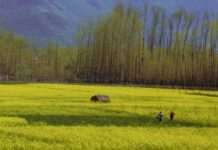





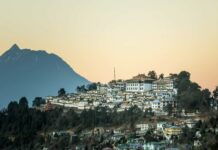












Wonderful article on seven sister states and their tourist attractions and circuits . Govt need to market and promote aggressively the tourism potential of the NE region in the domestic as well as international market. Very happy and pleased to read about my state and my region
North East deserves much more than it got. Given the scenic beauty it commands, it can be easily developed into major tourist spots, provided AFSPA & other Restrictions are removed
Thank you !!!!! Have got many more up my sleeve, for you to enjoy…
[…] Disclaimer: This post is auto-aggregated by a computer program and has not been created or edited by SocialJasoos Source link […]
Great !! This article has really touched my heart as I belong to one of this regions.beautiful and vivid description indeed.Keep it up !!!